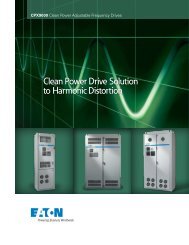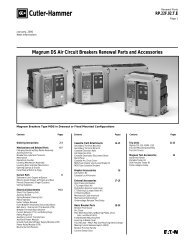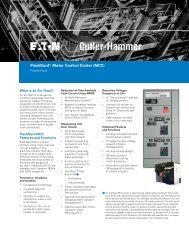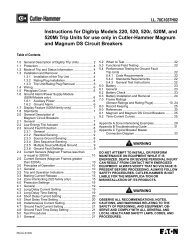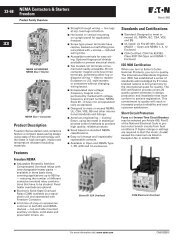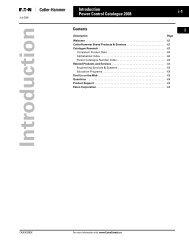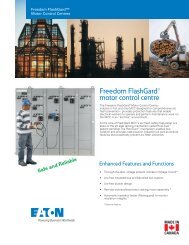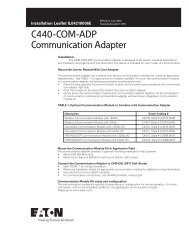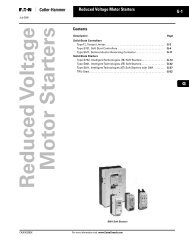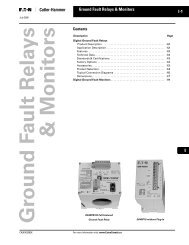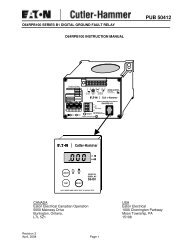M-Maxâ„¢ Series Adjustable Frequency Drive - Eaton Corporation
M-Maxâ„¢ Series Adjustable Frequency Drive - Eaton Corporation
M-Maxâ„¢ Series Adjustable Frequency Drive - Eaton Corporation
You also want an ePaper? Increase the reach of your titles
YUMPU automatically turns print PDFs into web optimized ePapers that Google loves.
Regenerative Braking<br />
If the rotor of an asynchronous motor is driven<br />
oversynchronously in the direction of the rotating field, it<br />
generates electric power via its stator windings. The motor<br />
becomes a generator. In the frequency inverter, this<br />
generative energy causes an increase in the DC link voltage.<br />
Oversynchronous speeds occur, for example, when the<br />
output frequency in frequency inverter operation is reduced<br />
with short deceleration times, the connected machine has a<br />
large flywheel mass, or when the flowing medium in pumps<br />
and fans works against the speed reduction.<br />
The rise in the DC link voltage is monitored by the M-Max<br />
frequency inverter and always enables a braking torque of<br />
around 30% of the motor rated torque. A higher braking<br />
torque can be achieved by selecting a more powerful<br />
frequency inverter. From the 1.1 kW (3.3A at 400V =<br />
MMX34AA3D3_) rating, the internal brake chopper with an<br />
external power resistor enables up to 100% of the rated<br />
motor torque.<br />
Regenerative Braking with External Braking Resistor<br />
1<br />
2<br />
M<br />
3 ~<br />
R+<br />
R–<br />
Item<br />
Number Description<br />
1 Machine flywheel mass<br />
2 Inverter with brake chopper (brake transistor)<br />
3 Brake resistor (RB)<br />
See Energy Flow (brake torque)<br />
3<br />
R B<br />
Parameters<br />
The brake chopper can be activated at parameter P12.5. This<br />
function is only activated with the three-phase frequency<br />
inverters MMX34…3D3_ (3.3A) to MMX34…014_ (14A).<br />
These ratings have an internal brake transistor that can<br />
dissipate excess brake energy via an external power resistor<br />
(connection terminals R+ and R–) when large flywheel<br />
masses or short deceleration times are involved.<br />
This parameter is not visible with frequency inverters without<br />
a braking transistor.<br />
M-Max <strong>Series</strong> <strong>Adjustable</strong> <strong>Frequency</strong> <strong>Drive</strong> MN04020003E—April 2011 www.eaton.com 113



